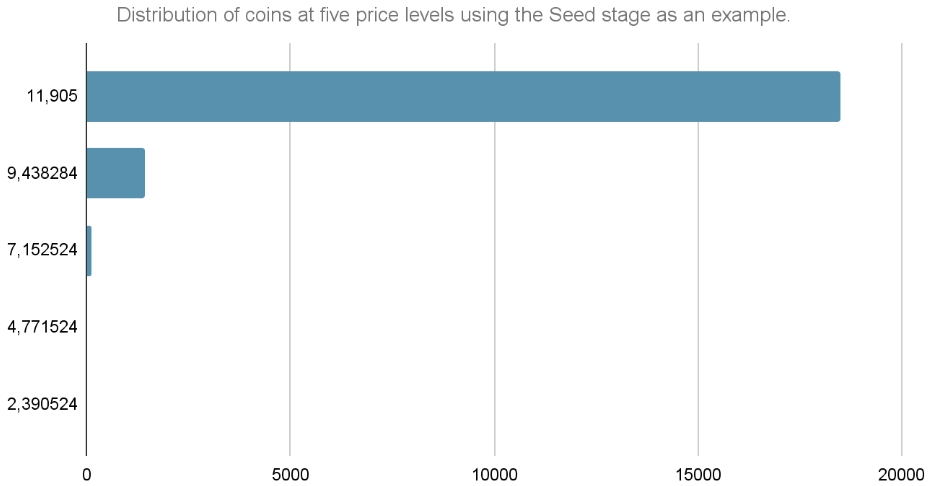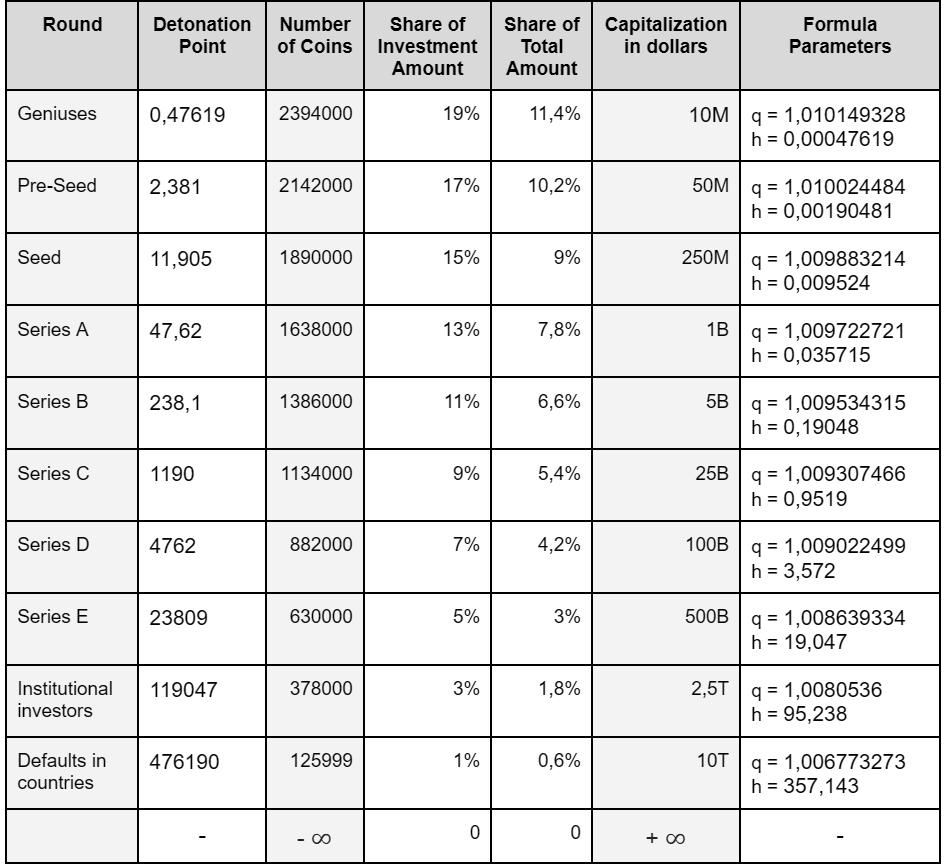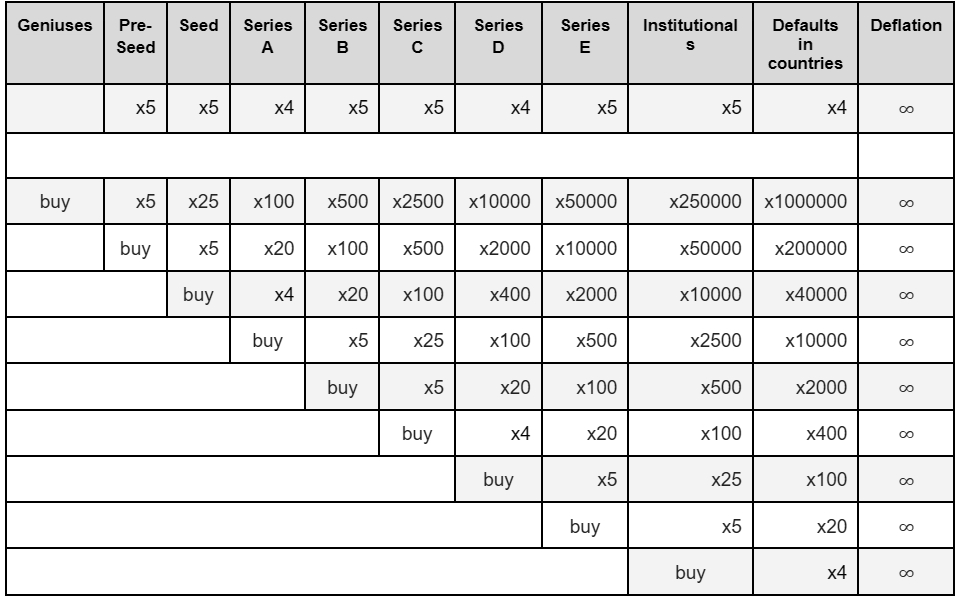3.13. Geometric Progression in Coin Distribution
At the time of writing this document, the global cryptocurrency and venture capital markets face the following challenges related to token and equity distribution:
1. Bitcoin
The mining mechanism for Bitcoin emission has not fostered the development of its technology or ecosystem. Instead, it has incentivized massive energy consumption and accelerated wear and tear of high-load equipment. This has resulted in significant environmental costs and inefficient resource usage for network maintenance rather than its improvement. Massive computational resources have been wasted on maintaining a relatively inefficient technology. This creates a paradox: an innovative financial system relies on a resource that harms the environment rather than enhancing it.
2. Altcoins
Most altcoins suffer from inefficient token distribution, creating substantial barriers to long-term development. Excessive token concentration in the hands of early investors or large funds leads to an imbalance of interests and increased risks of market manipulation. Limited token availability to the broader audience reduces decentralization and weakens community interest in the project. Additionally, these projects often face resource shortages for ecosystem development since their initial token distribution and investment strategies fail to prioritize long-term goals. This undermines trust in these projects, reduces their competitiveness, and limits their scalability potential.
3. Equities
The entire process from seed rounds to later stages takes place in closed environments involving only professional funds and major investors. Retail investors, on the other hand, gain access to equities only after IPOs, when the main growth phases have already been completed, and the value of the assets has already reached most of its potential. This leaves the lion’s share of profits with funds, while the broader audience gains access only at inflated prices. Moreover, the venture market’s professional participants often fail to assess promising projects effectively. Their formulas and models are frequently so abstract that they overlook critical trends. The neglect of Bitcoin and other cryptocurrencies during their early stages is just one example of their systemic shortcomings. Traditional approaches also fail to account for the potential of emerging technologies, as shown by undervalued assessments of many innovative companies.
To address these issues, a combined model was developed that integrates the best ideas from cryptocurrency and venture capital markets while eliminating their weaknesses.
This model is called the Geometric Progression in Coin Distribution and operates based on the following principles:
1. Stages.
The development of each investment attraction stage involved a detailed analysis of the funding rounds of companies with a market capitalization exceeding $1 trillion (Apple, Microsoft, Amazon, Alphabet, Saudi Aramco, Tesla, NVIDIA), as well as insights from leading cryptocurrencies. Based on this analysis, a structure of 10 investment stages was created to achieve maximum efficiency and sustainable growth for DeflationCoin:
First Stage: "Geniuses".
At this stage, coins are acquired by exceptional individuals from the venture investment world: true visionaries with a unique knack for identifying projects capable of changing the world. These investors possess experience, deep market understanding and courage to support ideas ahead of their time. They see potential not just in achieving a trillion-dollar capitalization but in creating a legacy that will go down in history. Investments attracted during this stage will be directed toward developing all mechanisms of DeflationCoin, excluding the components of the deflationary ecosystem.
Funding Stages: From 2nd to 8th (Pre-Seed, Seed, Series A, Series B, Series C, Series D, Series E).
During these stages, coins will be acquired by angel investors, crypto enthusiasts, and venture capital funds worldwide. The investments raised in these stages will be allocated to developing all elements of the deflationary ecosystem and their popularization and scaling. Together, these ecosystem elements will form a unique online-state with a diversified economy covering various segments. Each business unit of this ecosystem will allocate part of its monthly income to repurchase DeflationCoin, distribute it among stakers, and burn it, thereby enhancing the deflationary effect and strengthening the coin's value.
Ninth Stage: "Institutional Investors".
At this stage, institutional investors concerned about inflation and the declining value of their assets will begin actively purchasing coins. Approval of an ETF for DeflationCoin will allow pension funds, banks, and insurance companies to replace inflation-prone fiat currencies with a reliable asset featuring a deflationary mechanism. Investments raised at this stage will be directed toward the global popularization of the deflationary ecosystem elements, aiming to reach every country in the world and inform every individual on the planet about DeflationCoin.
Tenth Stage: "Defaults in Countries".
At the final stage, the primary growth catalyst for DeflationCoin will be defaults in countries with high levels of external government debt. Citizens of these countries, striving to preserve their assets, will find refuge in a reliable deflationary online-state that acts as a "hedge" against the instability of the outdated fiat system. History shows that major countries with high debt loads, such as Argentina, Venezuela, and Greece, have repeatedly faced economic crises and defaults. Each new default, bankruptcy or additional money issuance will become a catalyst for DeflationCoin's growth, strengthening its status as a global "safe haven." After this stage concludes, all DeflationCoin tokens will have been issued, and every transaction will enhance the deflationary effect, further reinforcing the cryptocurrency's value. DeflationCoin will become a unique asset recognized worldwide and a symbol of reliability amidst the instability of the global financial system.
2. Increasing Coin Scarcity with Rising Prices.
The number of coins allocated to each new stage gradually decreases as the price rises. This mechanism somewhat resembles Bitcoin's halving but with a key difference: the reduction in coin supply is not tied to time intervals or mining complexity, but it is determined solely by price growth. Unlike traditional mining, DeflationCoin eliminates the environmental impact associated with energy-intensive cryptocurrency mining processes. Instead, all attracted funds are directed toward project development, creating a sustainable model that does not harm the environment or humanity as a whole. (Details of the distribution are presented in the graph below).

3. Geometric Progression of Coin Placement
The distribution of coins at each stage is implemented based on the principle of geometric progression. Limit orders with DeflationCoin tokens will be placed on exchanges, gradually decreasing in accordance with this progress, which significantly enhances token scarcity. This approach ensures a daily reduction in supply, unlike Bitcoin’s halving, where the reduction occurs only once every four years.
Each stage has its own unique denominator of the geometric progression (the ratio of each subsequent sequence element to the previous one), which accelerates exponential price growth. This concept allows the most decisive investors to acquire the largest number of tokens at the most favorable price, providing a strategic advantage and increasing potential profitability.
An example of limit order distribution is shown in the graph below. The graph demonstrates a simplified version with five limit orders, whereas, in practical implementation, the number will be 1,000.

4. Detonation Point (DP)
The detonation point is the price level at which an investment stage is completed. Once this point is reached, the transition to the next stage occurs, accompanied by accelerated price growth. This happens because at the beginning of each new stage, the volume of available tokens is minimal, and as the next detonation point approaches, the number of tokens gradually increases (thanks to the "geometric progression of coin placement" principle).
The price placement of each detonation point is presented in the table below.
Table №4: Digital Parameters of All Investment Stages

Parameters indicated in the "Capitalization" column do not account for burned coins, and calculations are based on the base issuance of 20,999,999 coins. Upon reaching detonation points, actual capitalization will be higher.
h - price increment between limit orders, where coins are placed.
Details of the tokenomics are disclosed in Section 5.
The distribution of coins across price levels is calculated using the formula:
Formula Parameters:
- number of coins at the n-th price level;
- the first price level;
q - progression denominator (ratio of any term to the previous one);
n - the price level number.
As a result, this investment attraction concept eliminates the following issues:
Financing environmentally harmful mining instead of investing in the development of the cryptocurrency ecosystem (e.g., Bitcoin mining).
Lack of resources for the long-term development of cryptocurrencies, leading to additional token issuance and depreciation (e.g., altcoins).
Unavailability of profitable early-stage investments for most investors worldwide (e.g., closed funding rounds in the stock market).
The table below shows the potential returns for investors depending on the stages of purchasing and selling coins.
Calculations are based on predefined price ranges for each stage and the base issuance of 20,999,999 coins, excluding coins that will be gradually burned. The table allows investors to estimate the expected profit depending on the stage of coin acquisition.
Table №5: Potential Investor Returns.

This table clearly demonstrates that investors who acquire coins earlier gain a significant long-term advantage. Delays in decision-making can result in missed opportunities, with the best conditions lost to other, more decisive market participants. In such an environment, those investors who possess strategic thinking, the ability to anticipate market trends, and act promptly without procrastination are the ones who succeed.
The increasing scarcity of coins creates competition among investors, driving up prices and stimulating the development of the entire project ecosystem. This model attracts a wide range of participants, including central banks, venture funds, hedge funds, investment companies, and private investors from around the globe. The financial system of the crypto project offers the ability to preserve capital by protecting it from inflation and the opportunity to grow it thanks to the unique deflationary ecosystem of the asset.
Once the final stage of investment attraction is completed, all coins will have been issued, and the deflationary mechanism will fully manifest itself. From this point on, the supply of DeflationCoin will tend toward zero at an accelerated pace due to the built-in deflationary processes, while demand continues to grow as all elements of the deflationary ecosystem operate effectively.
Last updated